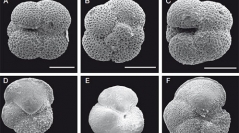

 Geodiversitas
30 (1) - Pages 79-96
Geodiversitas
30 (1) - Pages 79-96The Mio-Pliocene deposits of Djebel Diss (Mostaganem, Northwestern Algeria) are mainly constituted of marls including gypsy-calcareous beds with whitish limestone and stromatolithic limestone, closely comparable to those of the Murdjadjo carbonate platform. The sample analysis from studied sections (Djebel Aizeub, Sidi Abd Allâh, Douar Amarna) revealed successive planktonic foraminifera bio-events allowing to identify six biozones (Neogloboquadrina acostaensis p.p., Sphaeroidinellopsis seminulina, Globorotalia margaritae, G. puncticulata-G. margaritae, G. puncticulata and G. aemiliana p.p.), ranging from the Lower Tortonian to the Piacenzian stages. Thus, yellowish sandy marls and blue marls are attributed to the lower Tortonian (N. acostaensis p.p.), the Trubi marls to the Zanclean (S. seminulina, G. margaritae, G. puncticulata-G. margaritae) and to the Piacenzian stages (G. puncticulata and G. aemiliana p.p.). An important stratigraphic gap, corresponding to the upper Tortonian and the late Messinian, is observed. Therefore, the gypsy-calcareous beds, comprised between the lower Tortonian blue marls at the base and the Zanclean Trubi marls at the top, is considered as upper Messinian in age by correlation with the Mediterranean Basin evaporites which are positioned, in a synchronous way, at 5,94 or even 5,96 Ma.
Biostratigraphy, planktonic Foraminifera, later Tortonian, upper Messinian, Zanclean, Piacenzian, Djebel Diss, Chelif basin.